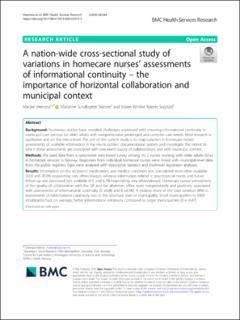| dc.contributor.author | Veenstra, Marijke | |
| dc.contributor.author | Skinner, Marianne Sundlisæter | |
| dc.contributor.author | Sogstad, Maren Kristine Raknes | |
| dc.date.accessioned | 2021-02-19T09:47:59Z | |
| dc.date.available | 2021-02-19T09:47:59Z | |
| dc.date.created | 2020-06-10T10:14:54Z | |
| dc.date.issued | 2020 | |
| dc.identifier.citation | BMC Health Services Research. 2020, 20 (464), . | en_US |
| dc.identifier.issn | 1472-6963 | |
| dc.identifier.uri | https://hdl.handle.net/11250/2729127 | |
| dc.description.abstract | Background
Numerous studies have revealed challenges associated with ensuring informational continuity in municipal care services for older adults with comprehensive, prolonged and complex care needs. Most research is qualitative and on the micro-level. The aim of the current study is to map variation in homecare nurses’ assessments of available information in the municipalities’ documentation system and investigate the extent to which these assessments are associated with perceived quality of collaborations and with municipal context.
Methods
We used data from a nationwide web-based survey among 1612 nurses working with older adults (65+) in homecare services in Norway. Responses from individual homecare nurses were linked with municipal-level data from the public registers. Data were analysed with descriptive statistics and multilevel regression analyses.
Results
Information on the recipients’ medications and medical condition was considered most often available (42.8 and 20.0% responding very often/always), whereas information related to psychosocial needs and future follow-up was perceived less available (4.5 and 6.7% responding very often/always). Homecare nurses’ perceptions of the quality of collaboration with the GP and the allotment office were independently and positively associated with assessments of informational continuity (ß =0.86 and ß =0.96). A modest share of the total variation (8%) in assessments of informational continuity was at the structural level of municipality. Small municipalities (< 5000 inhabitants) had, on average, better informational continuity compared to larger municipalities (ß = -0.47).
Conclusions
Documentation systems have a limited focus on long-term care needs of older care recipients beyond clinical and medical information. There is a potential for enhanced communication- and care-pathways between GPs, the allotment office and nurses in homecare services. This can support the coordinating role of homecare nurses in ensuring informational continuity for older adults with prolonged and complex care needs and help develop the facilitating role of (electronic) documentation systems. | en_US |
| dc.language.iso | eng | en_US |
| dc.publisher | BMC | en_US |
| dc.rights | Navngivelse 4.0 Internasjonal | * |
| dc.rights.uri | http://creativecommons.org/licenses/by/4.0/deed.no | * |
| dc.title | A nation-wide cross-sectional study of variations in homecare nurses’ assessments of informational continuity – the importance of horizontal collaboration and municipal context. | en_US |
| dc.type | Peer reviewed | en_US |
| dc.type | Journal article | en_US |
| dc.description.version | publishedVersion | en_US |
| dc.source.pagenumber | 11 | en_US |
| dc.source.volume | 20 | en_US |
| dc.source.journal | BMC Health Services Research | en_US |
| dc.source.issue | 464 | en_US |
| dc.identifier.doi | https://doi.org/10.1186/s12913-020-05313-3 | |
| dc.identifier.cristin | 1814709 | |
| dc.relation.project | Norges forskningsråd: 256644 | en_US |
| dc.description.localcode | © The Author(s). 2020 Open Access This article is licensed under a Creative Commons Attribution 4.0 International License | en_US |
| cristin.ispublished | true | |
| cristin.fulltext | original | |
| cristin.qualitycode | 2 | |

